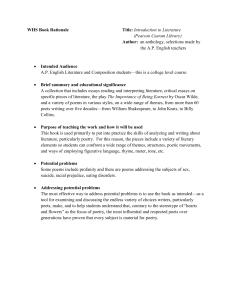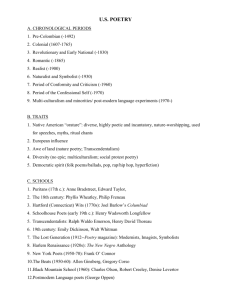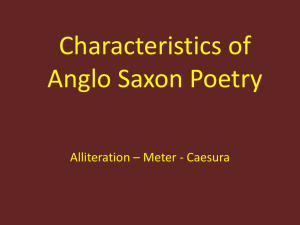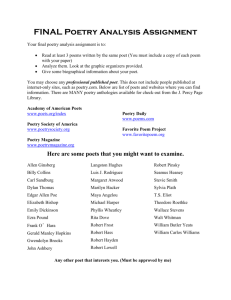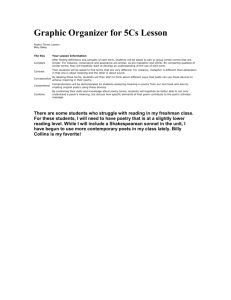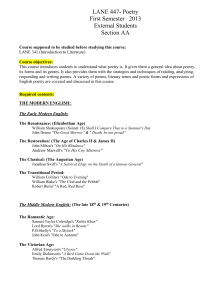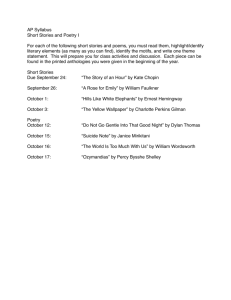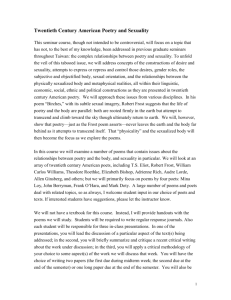Anglo-Saxon Literature
advertisement
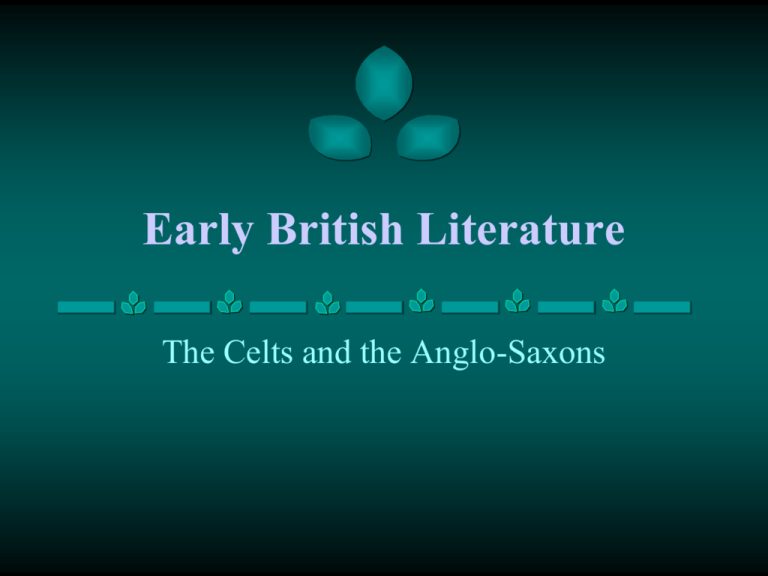
Early British Literature The Celts and the Anglo-Saxons Celtic Literature ð Ireland has the oldest vernacular tradition of literature in Europe with written texts dating from the 6th c. ð Old Irish: before 900 ð Middle Irish: 9001350 ð Late Middle/Early Modern Irish: 13501650 ð Modern Irish and Scots: 1650-present Irish Literature Brian Boru Harp Old Irish Literature ð The oldest writings are poems written in the margins of 6th c. continental manuscripts: short lyrics on religious or nature themes. ð The early literature has survived in Middle and Late Middle Irish manuscripts: miscellaneous collections of prose and verse containing legend, history, bardic and lyric poetry, and medical, legal, and religious texts from several periods The Scribe 8th-9th c A hedge of trees surrounds me. A blackbird’s lay sings to me. Above my lined booklet The trilling birds chant to me. In a grey mantle from the top of bushes The cuckoo sings. Verily—may the Lord shield me!— Well do I write under the greenwood. Major Irish Medieval MSS. Leabhar na hUidre [Book of the Dun Cow], p.73 ð The Book of the Dun Cow (before 1106): contains tales of the Ulster Cycle and Fenian legends ð The Book of Leinster (before 1160): contains heroic legends ð The Yellow Book of Lecan, The Great Book of Lecan,The Lebor Brecc, and the Book of Lismore (late 14th or early 15th c.) ð The Royal Irish Academy alone has more than 1300 mss. – mostly religious, historical and legal treatises Tain Bo Cuailinge: The Cattle Raid of Cooley from The Book of the Dun Cow Filí (Old Irish); File (Mod. Irish) ð The filí (filíd pl.) in the earliest times combined the functions of magician, lawgiver, judge, counselor to the chief, and poet. ð Later, but still at a very early time, the offices seem to have been divided: Brehons devoted themselves to the study of law, and the giving of legal decisions Druids claimed the supernatural functions, and priestly offices Filíd were principally poets and philosophers ð The division seems to have already existed in Ireland at the time of St Patrick, who was in constant opposition with the druids. ð Filíd underwent years of training to compose in verse the laws, genealogies, legends and traditions. Bards ð In Old Irish culture, the bards were the performers of the filíd’s poems ð They were record keepers and lineage holders, for the bards could determine a king's legitimacy. ð To satirize a king was to declare his access to the throne suspect. ð The role of the bard was historian and social commentator. They glorified heroes while insulting cowards and villains. ð They were both the newspaper and the opinion page. MACSWEENEY DINES AS BARD RECITES: "The work of the file or poet was recited to the accompaniment of a stringed instrument,. . . .The reacaire or reciter [bard] was a subordinate employee of the composer, who sat by the chieftain (his patron) enjoying his own composition." Declan Kiberd, "Irish Literature and Irish History, " in The Oxford Illustrated History of Irieland, ed. R. F. Foster (1989) Welsh Literature ð The earliest Welsh manuscripts date from the 12th c., but the earliest poetry comes from the 6th c. ð Before 1100: Y Cynfeirdd ("The earliest poets") or Yr Hengerdd ("The old poetry") ð The core tradition was praise poetry -patronage from kings and nobles. ð The other aspect of the tradition was the professionalism of the poets sustained by the Order of Bards, with a 'rule book' emphasizing the making of poetry as a craft. ð Poets undertook an apprenticeship of nine years to become fully qualified. Welsh Poets ð Nennius’ Historia Britonum list poets active during the reign of King Ida (547-59): "At that time, Talhaiarn Tataguen was famed for poetry, and Neirin [Aneirin], and Taliesin, and Bluchbard, and Cian, who is called Guenith Guaut, were all famous at the same time in British [that is Brythonic, or, Welsh] poetry." ð Poems by Taliesin and Aneirin are believed to have survived in the Book of Taliesin and Y Gododdin, Aneirin’s epic of a battle between the Celts and the Saxons. Roman Britain 1st-5th c. 5th Century: Celtic Disarray 408: Devastating attacks by Picts, Scots and Saxons led Britain to declare “independence” from Rome in 410. 440-450: Civil war and famine in Britain. Country divided along factional lines 445: Vortigen authorized use of Saxon mercenaries against Scots and Picts 450: adventus Saxonum: Hengest arrived with 3 ships of warriors. Saxons increased settlements. Anglo-Saxon Literature The Kingdoms of AngloSaxon England England as a Nation ð Bede may have been the first writer to articulate the idea of the English as one people in 732 in his History of the English Church and People. ð Viking Invasions ð Destroyed kingdoms of Northumbria and East Angles in the 860s ð Wessex emerged as the power that defeated the Vikings under Alfred the Great ð 878: Alfred defeated the Vikings at Edington ð At his death in 899, Alfred was the most powerful regional king in England House of Wessex Alfred the Great, his son Edward and wife Ealhswith at the Witan -- Assembly of the Wise Wessex: West Saxons Wessex Dynasty ð Edward the Elder (r. 899-924) succeeded his father Alfred and conquered the Midlands and East Anglia. ð His son, Athelstan (r. 924-40), brought the Scots, the Welsh, the Cumbrians and the Cornish under English rule by 928: he became King of all England and “Emperor of the World of Britain.” Tomb of King Athlestan in Malmesbury Abbey E or A = Æ House of Wessex Coin from King Edgar’s reign Canute of Denmark Ælgifu 1016-1035 Harthacanute Harold I 1040-42 1036-40 Alfred 1035-36 Genres: Prose ð Sermons: most popular of prose genres ð Translations of Latin religious works and Biblical works ð Saints’ Lives ð Legal texts: wills, records, deeds, laws, etc. ð Scientific and Medical texts ð Chronicles: historical writing: Anglo Saxon Chronicle The Anglo-Saxon Chronicle The initial page of the Peterborough Chronicle ð Collection of annals (yearly history) narrating the history of the Anglo-Saxon settlement in Britain. ð First continuous history written by Europeans in their own language. ð Probably begun during the reign of King Alfred in the 9th c. ð After completion of the original chronicle, copies were sent to monasteries and updated yearly. ð Nine surviving MSS. Known A-S Prose Writers ð King Alfred (849-99): translated a variety of Latin works such as Gregory’s Pastoral Care, Augustine’s Soliloquies and Boethius’s Consolation of Philosophy. ð Aelfric, abbot of Eynsham (9551020?): known as Grammaticus: greatest writer of A-S sermons, saints’ lives and Biblical glosses and translations. ð Wulfstan II, archbishop of York (10th c.): author of highly stylistic sermons and clerical legal texts. Alfred the Great Genres: Poetry ð ð ð ð ð Thula: alliterative lists of names or tribes Gnomic verse: proverbs, traditional wisdom Spells: invoke natural and supernatural powers Riddles: what am I? Religious poetry: retellings of Old Testament stories, saints’ lives, “Dream of the Rood” ð Adaptations of classical philosophical texts: e.g. Boethius’ Consolation of Philosophy ð Wisdom poetry: lyrical, meditative, elegiac – “The Wanderer,” “The Wife’s Lament,” etc. ð Heroic court poetry: celebration of historical events related by scops: Beowulf, etc. Manuscripts with Anglo-Saxon Poetry ð Exeter Book: Codex Exoniensis – 10th c. ms. ð Largest existing collection of Old English poetry ð Donated to the library of the Exeter Cathedral by Leofric, the first bishop of Exeter ð Contains “The Wanderer,” “The Seafarer,” “The Wife’s Lament,” “Widsith,” “The Ruin,” “Deor,” etc. ð Junius MS. – begun c. 1000 ce ð Anthology of religious poetry: Genesis, Exodus, Daniel, Christ and Satan ð Illustrated: only about one-third of illustrations completed ð Bodleian Library, Oxford University Junius MS: Angel Guarding the Gates of Paradise Manuscripts with Anglo-Saxon Poetry ð Vercelli Book – 10th c. ms. ð Cathedral Library, Vercelli, Italy ð Contains 23 sermons, a life of St. Guthlac and six poems including “The Dream of the Rood” ð Nowell Codex: Cotton Vitellius A xv – late 10th12th c. mss. ð British Library’s Cotton Collection ð Composite of two mss. Bound together in the 17th c. – damaged in an 18th c. fire in the Cotton Library ð 1st Codex (12th c): Old English prose: Alfred's translation of Augustine's Soliloquies, the Gospel of Nicodemus, “Solomon and Saturn”, and a fragment of a life of Saint Quentin. ð 2nd Codex (10th c): Beowulf, Judith and 3 prose works First page of Beowulf from the Cotton Vitellius MS. Beowulf Prologue What are those weird-looking letters? Omniglot Poetry ð ð ð ð Thula Alliterative lists of names and tribes Oral mnemonic device Found extensively in Widsith Technique also found in Old Testament Gnomic Verse ð Proverbs, traditional wisdom ð Hit becwæÞ – It is said “As the sea is smooth when storms are at rest, So people are quiet when peace is proclaimed.” (Exeter Book) Riddles The Anchor I war with the wind, with the waves I wrestle; I must battle with both when the bottom I seek, My strange habitation by surges o’er-roofed. I am strong in the strife, while still I remain; As soon as I stir, they are stronger than I. They wrench and they wrest, till I run from my foes; What was put in my keeping they carry away. If my back be not broken, I baffle them still. The rocks are my helpers, when hard I am pressed; Grimly I grip them. Guess what I’m called. The Exeter Book Spells and Charms Charm for a Swarm of Bees Take earth with your right hand and throw it under your right foot, saying: I've got it, I've found it: Lo, earth masters all creatures, it masters evil, it masters deceit, it masters humanity's greedy tongue. Throw light soil over them [the bees] as they swarm, saying: Sit, wise women, settle on earth: never in fear fly to the woods. Please be mindful of my welfare as all men are of food and land. Trans. Karl Young Known A-S Poets ð Cædmon: herdsman attached to the Whitby monastery during the abbacy of St. Hilda (657–681). Author of “Hymn,” oldest A-S poem ð The Venerable Bede (c. 672-735): Benedictine monk at Jarrow; author of the Historia Ecclesiastica: The History of the Church of England and “Bede’s Death Song” ð Cynewulf (fl. ca. 750): author of four poems, Christian narratives, Elene, Christ II, Juliana and The Fates of the Apostles. ð King Alfred (849-99) Depiction of Cædmon carved on a stone memorial cross on the grounds of St Mary's Church in Whitby Bede’s “Death Song” Fore ðæm nedfere nænig wiorðe ðonc snottora ðon him ðearf siæ to ymbhycgenne ær his hinionge hwæt his gastæ godes oððe yfles æfter deað dæge doemed wiorðe. Facing that enforced journey, no man can be More prudent than he has good call to be, If he consider, before his going hence, What for his spirit of good hap or of evil After his day of death shall be determined. Beda Venerabilis from an medieval manuscript Anglo-Saxon Poetic Conventions ð Elegiac mood: the transitoriness of life ð Ubi sunt: Where are they??? ð Heroic mode: active, loyal to kinship group, boastful ð The inevitability of Wyrd: fate ð Figures of speech ð Kennings: two words as metaphor for one: hron-rāde whale-road – sea; hord-cofan word-hoard – mind, thoughts ð Litotes: ironic understatement -- "That [sword] was not useless / to the warrior now." (Beowulf) ð Variation: parallel appositive phrases – see “Cædmon’s Hymn” ð Alliterative verse: alliteration is used as the principal device to unify lines of poetry Beowulf Prologue: Alliteration Wisdom Poetry ð Lyrical: expressions of feelings, meditations on life ð Emphasis on transitoriness of fame, glory, kinship, life itself: ubi sunt theme ð Boethian in exploration of fickle fortune Boethius: author of The Consolation of Philosophy ð Most found in Exeter Book: “The Ruin,” “The Wanderer,” “The Seafarer,” “The Wife’s Lament,” “The Husband’s Message” ð King Alfred: author of “Lays of Boethius” Heroic Court Poetry ð Narrative oral compositions handed down from generation to generation ð Interactive: warriors in the audience were given their turns to boast: to proclaim their self-worth in a stylized solo declamation, which all recognized as a beot or gilph (boast). ð Celebrations or commemorations of cultural heroes and historic events ð Sung at court feasts which also included mead drinking, gift giving, harp playing and displaying of trophies Anglo-Saxon Heroic Poems ð Beowulf (c. 700-1000) ð Fragments: The Fight at Finnsburh and Waldere ð The Anglo-Saxon Chronicle contains various heroic poems inserted throughout. ð 937: The Battle of Brunanburh celebrates the victory of King Athelstan over the Scots and Norse. ð Five shorter poems: Capture of the Five Boroughs (942); Coronation of King Edgar (973); Death of King Edgar (975); Death of Prince Alfred (1036); and Death of King Edward the Confessor (1065). The Scop ð ð ð ð ð ð ð ð Court singer Historian Genealogist Teacher Composer Critic Warrior Reporter “The Anglo-Saxon scop was a professional or semi-professional tribal poet who celebrated cultural values by singing epics on occasions of great ceremony and festivity…. He was a man of repute, the equal of thanes.” Anglo-Saxon Scops Artemesia Gentileschi, Judith Slaying Holofernes, 1612-13 ð Judith as model of psychic liberation -female who actsconfrontation of sexes from female point of view Artemesia Gentileschi, Judith and Her Maidservant 1613-1614 Artemesia Gentileschi, Judith Slaying Holofernes, 1620 Artemesia Gentileschi, Judith and Her Maidservant with the Head of Holofernes, c. 1625
